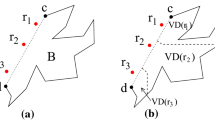Abstract
We present an algorithm for determining the shortest restricted path motion of a polygonal object amidst polygonal obstacles. The class of motions which are allowed can be described as follows: a designated vertex,P, of the polygonal object traverses a piecewise linear path, whose breakpoints are restricted to the vertices of the obstacles. The distance measure being minimized is the length of the path traversed byP. Our algorithm runs in timeO(n 4kogn). We also discuss a variation of this algorithm which minimizes any positive linear combination of length traversed byP and angular rotation of the ladder aboutP. This variation requiresO(n 5) time.
Similar content being viewed by others
References
T. Asano, T. Asano, L. Guibas, J. Hershberger, and H. Imai, Visibility-polygon search and Euclidean shortest paths,Proceedings of the 26th IEEE Symposium on Foundations of Computer Science, 1985, pp. 155–164.
R. Brooks, Solving the find-path problem by good representation of free space,IEEE Trans. Systems Man Cybernet.,13 (1983), 190–197.
E. W. Dijkstra, A note on two problems in connexion with graphs,Numer. Math.,1 (1959), 269–271.
M. L. Fredman and R. E. Tarjan, Fibonacci heaps and their uses in improved optimization algorithms,Proceedings of the 25th IEEE Symposium on the Foundations of Computer Science, 1984.
R. C. Larson and V. O. Li, Finding minimum rectilinear distance paths in the presence of barriers,Networks,11 (1981), 285–304.
D. Leven and M. Sharir, An efficient and simple motion-planning algorithm for a ladder moving in two-dimensional space amidst polygonal barriers, Technical Report, Tel Aviv University, Tel Aviv, 1984.
T. Lozano-Perez and M. A. Wesley, An algorithm for planning collision-free paths among polyhedral obstacles,Comm. ACM,10 (1979), 560–570.
J. S. B. Mitchell, An autonomous vehicle navigation algorithm,Proceedings of the SPIE on Applications of Artificial Intelligence, 1984, pp. 153–158.
J. S. B. Mitchell, Shortest rectilinear paths among obstacles, Technical Report, Department of Operations Research, Stanford University, 1986.
J. S. B. Mitchell, Planning shortest paths, Thesis, Department of Operations Research, Stanford University, 1986.
J. S. B. Mitchell, D. M. Mount, and C. H. Papadimitriou, The discrete geodesic Problem, Manuscript, Department of Operations Research, Stanford University, 1985.
C. O'Dúnlaing, M. Sharir and C. K. Yap, Retraction: a new approach to motion-planning,Proceedings of the 15th ACM Symposium on the Theory of Computing, 1983, pp. 207–220.
C. H. Papadimitriou, An algorithm for shortest-path motion in three dimensions,Inform. Process. Lett.,20 (1985), 259–263.
F. P. Preparata and M. I. Shamos,Computational Geometry, Springer-Verlag, New York, 1985.
J. Reif, Complexity of the mover's problem and generalizations,Proceedings of the 20th IEEE Symposium on Foundations of Computer Science, 1979, pp. 421–427.
J. H. Reif and J. A. Storer, Shortest paths in Euclidean space with polyhedral obstacles, Manuscript, Aiken Computation Laboratory, Harvard University, 1984.
J. T. Schwartz and M. Sharir, On the piano movers' problem: I. The case of a two-dimensional rigid polygonal body moving amidst polygonal barriers,Comm. Pure Appl. Math.,36 (1983), 345–398.
J. T. Schwartz and M. Sharir, On the piano movers' problem: III. Coordinating the motion of several independent bodies: the special case of circular bodies moving amidst polygonal barriers,Internat. J. Robotics Res.,2(3) (1983), 46–75.
J. T. Schwartz and M. Sharir, On the piano movers' problem: V. The case of a rod moving in three-dimensional space amidst polyhedral obstacles,Comm. Pure Appl. Math.,37 (1984), 815–848.
M. Sharir and E. Ariel-Sheffi, On the piano movers' problem: VI. Various decomposable two-dimensional motion-planning problems, Technical Report 58, Computer Science Department, Courant Institute of Mathematical Sciences, New York University, New York, 1983.
M. Sharir and R. Livne, On minima of functions, intersection patterns of curves, and Davenport- Schinzel sequences,Proceedings of the 26th Symposium on Foundations of Computer Science, 1985, pp. 312–320.
M. Sharir and A. Schorr, On shortest paths in polyhedral spaces, Technical Report00, Tel Aviv University, Tel Aviv, 1984.
Author information
Authors and Affiliations
Additional information
Communicated by Chee-Keng Yap.
Research partially supported by a grant from the Hughes Artificial Intelligence Center, part of Hughes Aircraft.
Rights and permissions
About this article
Cite this article
Papadimitriou, C.H., Silverberg, E.B. Optimal piecewise linear motion of an object among obstacles. Algorithmica 2, 523–539 (1987). https://doi.org/10.1007/BF01840372
Received:
Revised:
Issue Date:
DOI: https://doi.org/10.1007/BF01840372




